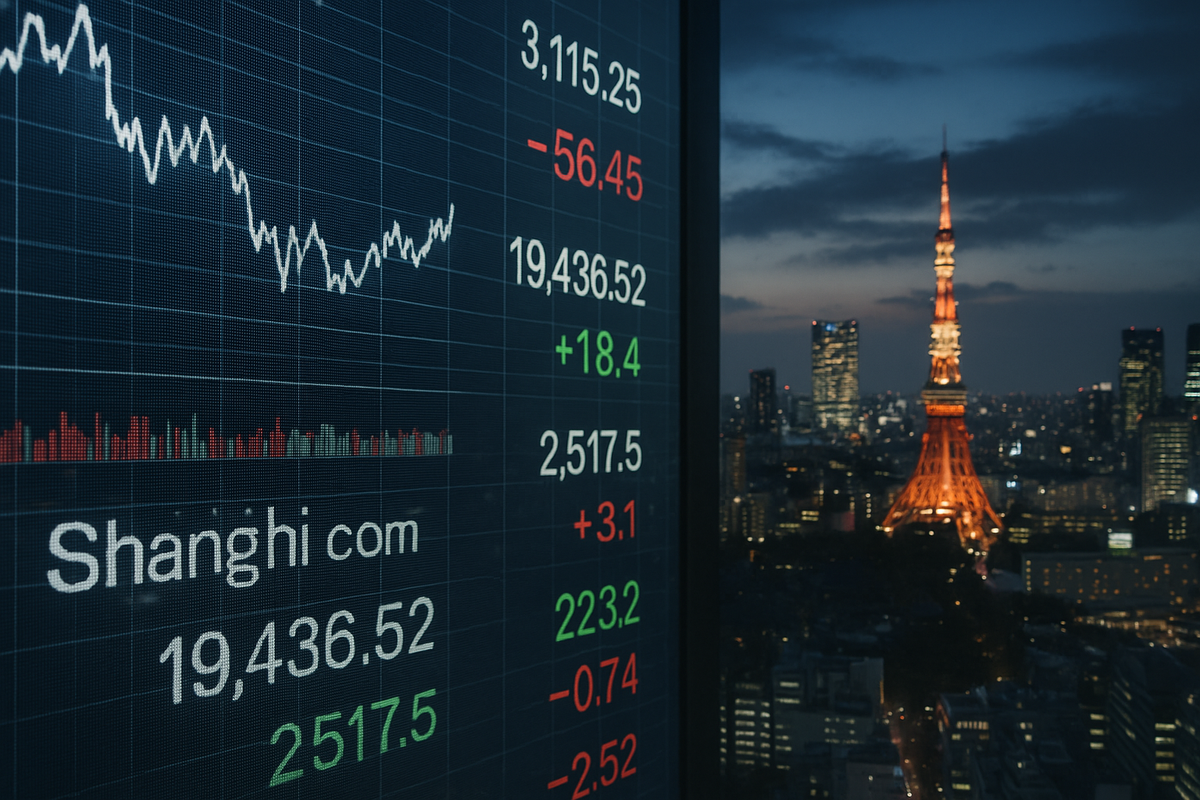
Global financial markets presented a fragmented picture today, with most Asian indices experiencing declines while European bourses showed a mixed performance. The standout anomaly was Tokyo's Nikkei 225, which surged significantly, bucking the regional trend and signaling a unique resilience within the Japanese economy. This divergence highlights the complex interplay of local economic factors, monetary policies, and global investor sentiment shaping market movements across different geographies. The immediate implication is a heightened focus on the underlying drivers of these disparate performances, particularly the factors bolstering Japanese equities amidst broader regional weakness.
Asian Markets Stumble While Tokyo Soars: A Tale of Two Trends
Today's market activity painted a stark contrast across global bourses. While most Asian markets experienced a downturn, Tokyo's Nikkei 225 (TYO: N225) defied the trend with a significant surge. Hong Kong's Hang Seng Index (HKG: HSI) sagged by 0.9%, closing at 24,858.82, while South Korea's Kospi (KRX: KOSPI) declined by 0.6% to 3,210.01. Australia's ASX 200 (ASX: XJO) subtracted 0.3% to 8,807.12, and Singapore's Straits Times Index (SGX: STI) backtracked 0.4% to 4,239.83. China's Shanghai Composite index (SHA: 000001) shed 0.3% to 3,635.13.
In stark contrast, the Nikkei 225 spiked 1.9% to 41,820.48, with the broader Topix index also hitting a fresh record, trading above 3,000 for the first time. This remarkable performance was primarily driven by a confluence of positive factors. Strong quarterly earnings reports from major Japanese companies, such as SoftBank Group (TYO: 9984) which rallied as much as 11% after swinging back to profitability, and Sony Group (TYO: 6758) which climbed over 3.5% after lifting its full-year operating profit forecast, significantly boosted investor sentiment.
Furthermore, the resolution of US tariff issues played a crucial role. Japanese officials announced that the U.S. had agreed to correct discrepancies in newly imposed tariffs on Japanese goods, which initially exceeded the agreed 15% rate. This news, including expectations that the U.S. would stop stacking universal tariffs and reduce car taxes, particularly benefited export-driven automakers like Toyota Motor Corp. (TYO: 7203), which jumped 3.5%, and Honda Motor Co. (TYO: 7267), up 4%. The weaker yen also provided a competitive edge for Japanese companies in international markets, bolstering export-driven stocks. The Bank of Japan's accommodative policy approach, signaling an ongoing dovish stance on interest rates, continued to support market optimism and encourage growth in Japan's economy.
European markets, meanwhile, presented a mixed bag. The UK's FTSE 100 (LON: UKX) showed modest gains, influenced by strength in energy stocks and a weaker British pound, despite the Bank of England's recent interest rate cut. The CAC 40 (EPA: PX1) in Paris advanced by 0.3%, while the DAX 40 (ETR: DAX) in Frankfurt showed slight declines or remained flat. Initial reactions in European markets were characterized by cautious optimism, with investors weighing the impact of central bank policies, economic data, and corporate earnings.
Winners and Losers in a Fragmented Market
The fragmented market performance has created clear winners and losers across Asia and Europe. In Japan, SoftBank Group (TYO: 9984) emerged as a significant winner, with its stock jumping 13-14% and reaching record highs. This surge is primarily attributed to the revival of the SoftBank Vision Fund, which posted a profit of ¥451.39 billion, driven by a rebound in global technology valuations and strong performances from its portfolio companies like Coupang (NYSE: CPNG) and Symbotic (NASDAQ: SYM). SoftBank's strategic investments in AI and semiconductor technology, including a significant increase in its stake in Nvidia (NASDAQ: NVDA) and a commitment of $30 billion to OpenAI, have further bolstered investor confidence.
Sony Group (TYO: 6758) also demonstrated strong performance, with its stock climbing over 3.5%. The company reported stronger-than-expected first-quarter results for fiscal year 2025, with consolidated sales growing 2% year-on-year. Its Game & Network Services (G&NS) segment was a key driver, with an 8% revenue increase and a substantial 127% jump in operating income, largely due to a surge in network service revenue and strong sales of third-party game titles. Sony's strategic move to reduce its stake in its financial unit and prepare for a partial spin-off has been well-received by investors, signaling a focus on its core entertainment business.
Japanese automakers Toyota Motor Corp. (TYO: 7203) and Honda Motor Co. (TYO: 7267) experienced mixed fortunes. While both saw their stock prices rise due to the resolution of US tariff issues, they have faced significant headwinds. Toyota's operating profit declined by almost 11% in Q1 FY26, and net income fell by 37%, primarily attributed to adverse exchange rate fluctuations, higher material prices, and the substantial negative impact of recent U.S. import duties. Honda experienced a steep 50% drop in its first-quarter net profit year-on-year, falling below analyst expectations, largely due to a significant tariff hit from U.S. trade policies and one-time EV-related write-downs. Both companies are grappling with increasing competition from aggressive Chinese EV manufacturers like BYD (HKG: 1211) and Geely (HKG: 0175).
Beyond Japan, Huawei (SHE: 002502) in China remains a leading provider of 5G infrastructure despite U.S. sanctions, benefiting from significant government funding for AI innovation. Samsung Electronics (KRX: 005930) in South Korea, a leader in semiconductors and AI, benefited from Apple's (NASDAQ: AAPL) decision to source chips from its Texas factory and was exempted from proposed U.S. chip tariffs. In Europe, Rolls-Royce Holdings (LON: RR) saw its shares surge after reporting strong first-half results and raising its earnings guidance, while Hensoldt (ETR: HAG) in Germany rallied after reporting solid revenue growth and a record order backlog.
Conversely, many Asian markets, including Hong Kong, experienced deep losses due to the imposition of U.S. tariffs, with Chinese manufacturers facing severe challenges as U.S. duties disrupted trade flows. In Europe, companies like Accor (EPA: AC) and Sanofi (EPA: SAN) experienced declines despite reporting increased earnings, while Puma (ETR: PUM) saw its stock tank nearly 16% after slashing its earnings forecast for the year, citing weak demand and concerns about U.S. tariffs.
Industry Impact and Broader Implications
The current market dynamics are deeply embedded within broader industry trends, particularly the ongoing Artificial Intelligence (AI) boom, evolving trade policies, and strategic central bank actions. The significant surge in Tokyo's Nikkei, fueled by strong earnings from tech and export-oriented companies, underscores the profound impact of the AI revolution. Companies that effectively harness AI, like SoftBank with its substantial investments in OpenAI and Nvidia, are gaining a significant competitive advantage, potentially securing larger market shares by anticipating customer needs and optimizing operations. This trend is creating a dynamic competitive landscape where businesses failing to adapt risk market disruption, potentially leading to consolidation or the emergence of new "AI-native" players.
Trade policies, characterized by both protectionist measures and efforts towards liberalization, are also exerting considerable influence. The resolution of US tariff issues benefiting Japanese automakers like Toyota and Honda highlights the direct impact of these policies on corporate profitability and market sentiment. Conversely, the continued imposition of tariffs on various Asian markets, including Hong Kong and China, directly increases the cost of imported goods, squeezing profit margins for businesses and leading to higher prices for consumers. This creates uncertainty, which can erode confidence in trading partners and slow economic growth globally. Historically, trade policies have swung between protectionism and liberalization, with the current era showing a renewed emphasis on regional and bilateral trade agreements and the strategic use of tariffs as a policy tool.
Central bank actions, particularly interest rate adjustments and accommodative policies, are another critical factor. The Bank of Japan's dovish stance has continued to support market optimism and encourage growth in Japan's economy, contributing to the Nikkei's surge. Conversely, the Bank of England's recent rate cut influenced the FTSE 100, impacting sterling and the relative value of the index's overseas earnings. Major central bank policy shifts can have a "global ripple effect," leading to capital outflows from emerging markets as investors seek safer assets, which can result in currency devaluations and financial instability in developing economies. The rapid evolution of AI technology has also outpaced existing regulatory frameworks, leading to concerns about national security, safety, privacy, bias, misinformation, intellectual property rights, and job displacement, prompting jurisdictions to adopt varying regulatory approaches.
What Comes Next
The immediate future for global markets will likely be characterized by continued volatility and a heightened focus on economic data and central bank pronouncements. In the short term, investors will closely monitor upcoming corporate earnings reports, particularly from companies with significant exposure to AI and international trade, to gauge the sustainability of current trends. The performance of the Japanese market will be a key indicator, as its resilience amidst broader Asian weakness suggests a potential decoupling driven by unique domestic factors and strategic investments. Further clarity on US trade policies and their implementation will also be crucial, as any shifts could significantly impact export-oriented economies.
In the long term, the trajectory of AI development and its integration across industries will be a dominant theme. Companies that continue to innovate and invest in AI will likely see sustained growth, while those that lag behind may face increasing competitive pressure. The regulatory landscape for AI is also expected to evolve rapidly, with potential implications for data privacy, ethical considerations, and market access. Furthermore, central banks will continue to navigate the delicate balance between controlling inflation and fostering economic growth, with their monetary policy decisions having far-reaching consequences for global capital flows and asset valuations. The ongoing geopolitical tensions and their potential impact on supply chains and trade routes will also remain a significant factor influencing market sentiment.
Potential strategic pivots or adaptations will be required for businesses to thrive in this evolving environment. Diversifying supply chains, investing in automation and AI-driven efficiencies, and adapting to changing consumer preferences will be paramount. Market opportunities may emerge in sectors poised to benefit from AI adoption, such as specialized software development, data analytics, and cybersecurity. Conversely, challenges may arise for industries heavily reliant on traditional manufacturing or those vulnerable to trade protectionism. Investors should prepare for potential scenarios ranging from a continued divergence in regional market performance to a more synchronized global recovery, depending on the interplay of these complex factors.
Conclusion
Today's mixed global market performance, with Asian markets largely lower and Tokyo's Nikkei defying the trend, underscores the intricate and often divergent forces shaping the financial landscape. The key takeaways from this event highlight the significant impact of strong corporate earnings, particularly in the technology sector, and the crucial role of trade policy resolutions in boosting investor confidence. The Nikkei's surge, driven by companies like SoftBank and Sony, demonstrates the power of strategic investments in AI and the benefits of a weaker yen for export-oriented industries. Conversely, the struggles of other Asian markets and the mixed performance in Europe underscore the ongoing challenges posed by trade tensions and broader economic uncertainties.
Moving forward, the market will likely remain sensitive to developments in AI innovation, trade negotiations, and central bank policies. Investors should closely watch for further clarity on regulatory frameworks for AI, as these will significantly influence the growth trajectory of technology companies. The ongoing evolution of trade relationships, particularly between major economic blocs, will continue to shape the fortunes of export-driven industries and global supply chains. Finally, central bank decisions on interest rates and monetary policy will remain a critical determinant of market liquidity and investor appetite for risk. The lasting impact of these events will depend on how effectively governments and businesses adapt to these evolving dynamics, with a clear emphasis on technological advancement and resilient global trade.






